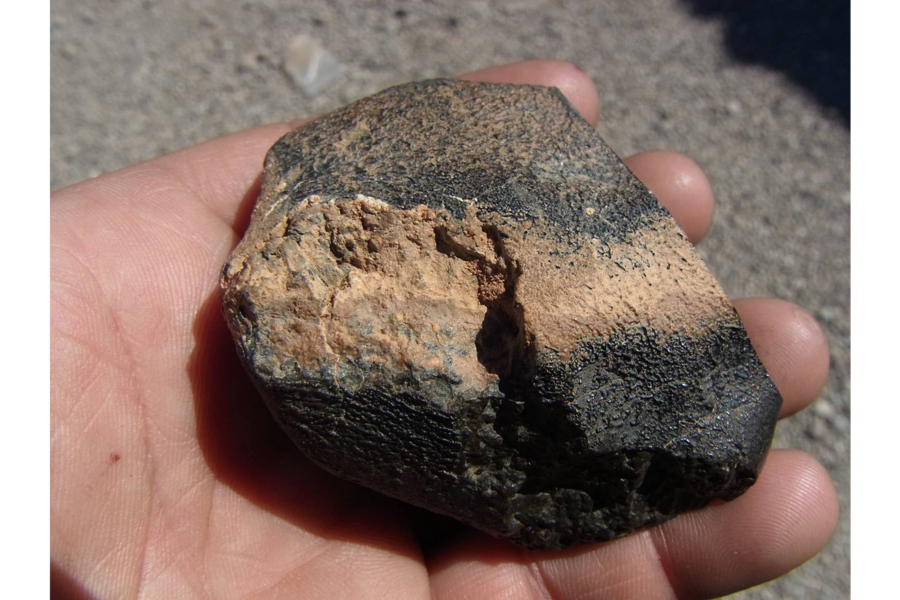What can a Martian meteorite tell us about volcanism on the Red Planet?
Loading...
A rock that fits in the palm of a scientist's hand and weighs less than a pound is helping paint a picture of the history of volcanism on Mars. That's because the little igneous rock broke off the Red Planet when something slammed into the Martian surface about 1.1 million years ago. It hurtled through space and then fell to Earth, landing in the desert in Algeria.
Yes, it's a Martian meteorite.
Northwest Africa (NWA) 7635, as the meteorite has been dubbed, wasn't the only igneous rock ejected from Mars at the time. Researchers have discovered at least 10 others with the same cosmic ray exposure, evidence that they, too, flew through space after breaking off Mars around the same time.
But NWA 7635 doesn't fall neatly into the same category as those other Martian meteorites, called shergottites. While the shergottites solidified from lava no more than 600 million years ago, NWA 7635 is about 2.4 billion years old, according to new research published Wednesday in the journal Science Advances.
And this could mean that one Martian volcano was erupting for at least 2 billion years.
This confirms previous ideas that volcanic activity in a particular site on Mars can last a long time, says study lead author Thomas Lapen, a geologist at the University of Houston.
Researchers have two main lines of evidence for the geological processes that shape the surface of the Red Planet, he explains in a phone interview with The Christian Science Monitor. Researchers can study these meteorites, or they can study data from the surface of the planet, as recorded by orbiters, landers, and rovers.
The latter vein of study has long suggested that big volcanic centers on Mars, such as Tharsis and Elysium, could have formed as long ago as 3 or 4 billion years ago, says Harry "Hap" McSween, a geoscientist at the University of Tennessee Knoxville who was not involved in the research. "It's nice to have confirmation," he tells the Monitor.
Not everyone is convinced, though. These Martian meteorites may actually be much older than Dr. Lapen and his colleagues report, says Audrey Bouvier, Canada Research Chair in Planetary Materials and curator of the Western Meteorite Collection at the University of Western Ontario.
Dr. Bouvier, whose own research suggests some depleted shergottites are actually 4.3 billion years old, explains in an email to the Monitor that Lapen's dates could actually be shock ages – a sort of resetting of the rock's minerals as a result of meteor impact.
But other meteorite scientists, including Dr. McSween, don't doubt Lapen's dating.
"I would say I definitely agree with the age dating," Chris Herd, a geoscientist and curator of meteorites at the University of Alberta who was not involved in the research, tells the Monitor in a phone interview. "The group is, especially the first author, very well-known for doing excellent work with these radiogenic isotopes – the age dating – and so I have little doubt about the age that they obtain."
Carl Agee, director of the Institute of Meteoritics at the University of New Mexico who also wasn't involved in the research, agrees. "I think that they've made a really good argument for this case that there's long-lived volcanism in a particular location on Mars," he says in a phone interview with the Monitor. "And the way that they do it is hard to argue with."
That's not to say that NWA 7635 doesn't present other puzzles, the scientists say.
"It has a different mineralogy" from the other shergottites, Dr. Agee says. "It has some characteristics that are reminiscent of shergottites, but it really is an outlier."
This suggests that perhaps the older rock crystallized under different conditions from the younger ones, Dr. Herd says. And that introduces a number of questions.
One way to explain this would be if NWA 7635 was actually ejected from a different site on Mars than the other meteorites and therefore wasn't actually evidence that one volcanic center was active for at least 2 billion years. But, Herd says, it would be an unlikely coincidence if two impactors struck Mars around the same time 1.1 million years ago, knocking off these meteorites.
Instead, this difference in composition could say something about the change in the magma bubbling up from the Martian mantle over time, and therefore the geologic history of Mars more broadly.
On Mars, plate tectonics don't drive geological processes like they do on Earth. Instead, volcanoes are the result of hotspots arising from deep within the planet, like the volcanoes that formed Hawaii and Iceland.
Without plate tectonics to move a plate over the fountain of magma, Martian hot spots can produce much larger volcanoes than Earth's. This is how researchers explain the size of Mars's Olympus Mons, the largest volcano known in the solar system. It could also explain why volcanic centers could be active for as long as this new study suggests.
Although "the wealth of information that we can get from a single, small sample is really quite amazing," Herd says, the meteorites would be even more useful if researchers knew where exactly on the Martian surface they came from.
As such, McSween points out, one of the objectives of NASA's Mars 2020 mission is to have the rover collect and cache rocks to be returned to Earth at a future date. But, he adds, returning samples to Earth will be a tricky, costly process. So, for now, he says, "these meteorites are the cheapest spacecraft mission."








